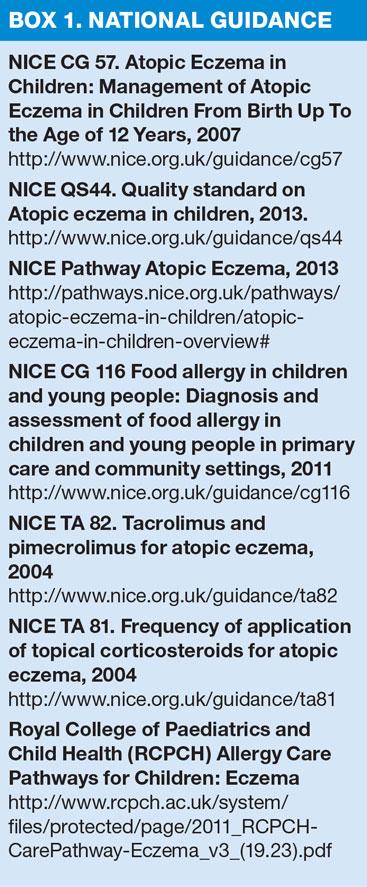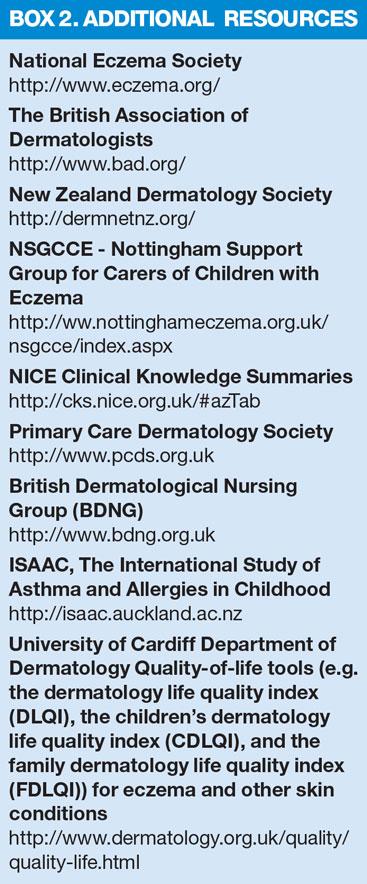Clothing for eczema study
Sandra Lawton RN, OND, RN Diploma (Child) ENB 393, MSc,
Sandra Lawton RN, OND, RN Diploma (Child) ENB 393, MSc,Nurse Consultant Dermatology, Queen's Nurse Queen's Medical Centre, Nottingham University Hospitals NHS Trust and Professor Kim Thomas Professor of Applied Dermatology Research Divisionof Rheumatology, Orthopaedics and Dermatology School of MedicineUniversity of Nottingham
Three hundred children are being recruited for a clinical trial to establish whether or not specialist silk clothing really does help in the treatment of eczema. The £1m CLOTHES trial - Clothing for the relief of Eczema Symptoms - is being led by Professor Kim Thomas from the Centre of Evidence Based Dermatology at the University of Nottingham.
INTRODUCTION
Atopic eczema, also described as eczema, childhood eczema and atopic dermatitis, is a common skin condition affecting 20% of school-age children.1 It has a significant impact on the lives of both the children and their families, with studies showing that atopic eczema has a significant impact – and in some cases more so – on their quality of life compared with other chronic childhood conditions.2 While most cases of eczema can be successfully treated with topical medications, which include the use of regular emollients and topical corticosteroids, many parents frequently express concern about using these preparations – especially topical corticosteroids –which impacts on adherence with treatment plans.3 Many are keen to explore non-pharmacological treatment options and one aspect of care we are commonly asked about is the use of silk clothing. This article focuses on the current evidence relating to the use of silk clothing.
NATIONAL GUIDANCE
Children and their families will meet a variety of health care professionals during their eczema journey. What matters to parents and children is not only the guidance (Box 1) but also their ability to manage the condition on a daily basis. To do this they need to be supported by competent health care professionals who can provide practical advice, demonstrate treatments and provide realistic plans of care, which are supported by guidance together with additional information and resources.4 (Box 2).
CLOTHING AND ECZEMA
It has long been understood that clothing can cause irritation to the skin, and current guidelines recommend the use of loose cotton clothing, and the avoidance of wool and other rough fibres next to the skin. In response to this need, new clothing products have become available in recent years, and these are now marketed as having beneficial effects in the treatment of eczema. Therapeutic silk garments are available on prescription on the NHS, but the trial evidence supporting their use is currently limited. The effectiveness of these therapeutic silk garments is lodged as a treatment uncertainty in the UK Database of Uncertainties about the Effectiveness of Treatments (DUETs).5,6
EXISTING RESEARCH
The 2000 Health Technology Assessment systematic review of eczema treatments (Hoare, Li Wan Po et al. 2000) found no RCTs looking at therapeutic clothing for the treatment of eczema,7 although there was some evidence to suggest that smoother fibres were less aggravating to eczematous skin.8 This review has recently been updated and has revealed six small RCTs looking at therapeutic clothing for the treatment of eczema: two using silver coated textiles;9,10 one using Mediele®;11 one using Ethylene Vinyl Alcohol (EVOH) fibre;12 and two randomized controlled trials using DermaSilk.13,14 These silk clothing trials were too small (22 and 30 participants respectively) and of too limited duration (12 and 4 weeks respectively) to inform clinical practice.
THE CLOTHES TRIAL – UK STUDY
Specialist silk clothing has been promoted recently as a new treatment option for people with eczema, but it is unclear if these garments really do provide additional benefits for patients. A high quality, independent clinical trial is needed to establish whether or not these new products are beneficial for patients and cost-effective for the NHS. As a result, the National Institute for Health Research Health Technology Assessment programme has commissioned a large-scale, multi-centre randomised controlled trial of silk clothing for the management of eczema in children.
Professor Thomas said: ‘There have been some impressive claims recently promoting specialist silk clothing as a new treatment option for people with eczema. However, it is still unclear if these garments really do provide additional benefits for patients. We are carrying out the first large-scale independent, randomised controlled trial of silk clothing for the management of eczema in children to establish whether or not these new products live up to the claims that are currently being made.’
The trial will compare the use of silk clothing in addition to normal eczema care, versus normal eczema care alone. Children enrolled in the study will be put into one of two groups. The first group will receive three sets of silk underwear – this will be either a bodysuit and leggings, or vest and leggings depending on the child’s age. The children will be asked to wear the clothing underneath their normal clothes day and night for six months – if possible! Children who do not receive the clothing straight away will be given the clothing to try for themselves for two months after the first six months of the trial has finished. Throughout the trial all of the children will be free to continue with their usual eczema treatments, such as emollients and topical steroids. If the research can show that these garments provide additional benefits for patients, then this would be an important finding, and many eczema sufferers could benefit. Equally, if the research shows that the clothes provide no useful benefit, then patients and the NHS can save money by not using treatments that have been shown to be ineffective. In addition to the main trial there will be a nested qualitative element to elicit detailed information firstly from parents or guardians and children about factors that influence the use of silk clothing, and secondly, prescribers’ and commissioners’ views on factors that influence their decisions to offer silk clothing in the management of childhood eczema.
Who can take part?
Children aged between 1 and 15 years of age who have moderate to severe eczema will be eligible to take part in the trial. Recruitment is taking place in hospitals in five main areas – Nottingham, Cambridge, north London, Portsmouth and the Isle of Wight. Each child will be enrolled in the trial for eight months in total, and will be asked to attend their local recruiting hospital on four different occasions throughout the trial period. Children taking part in the trial will be asked to complete a weekly questionnaire at home to record eczema severity and how often the clothing has been worn. The team are looking for 300 children to take part in the trial. Recruitment started in November 2013 and will continue for about 18 months. Further details about the study can be found on the CLOTHES trial website www.nottingham.ac.uk/CLOTHES
CONCLUSION
Eczema care and management is multifaceted both for health care professionals, children and their families. It is important that the care we provide is based on the most up to date evidence. This may not only benefit the children with eczema but also ensure that we use NHS resources wisely.
Disclaimer: The trial is being funded by the National Institute for Health Research Health Technology Assessment Programme (ref: 11/65/01), and led by Professor Kim Thomas. The views expressed in this article are those of the authors and not necessarily those of the NHS, the National Institute for Health Research or the Department of Health.
REFERENCES
1. Wedgeworth EK, Sharp H, Powell A, et al What's New in Eczema? Part 1: Epidemiology and Pathophysiology. Dermatological Nursing 2012:11(4):9-15
2. Beattie PE, Lewis-Jones MS. A comparative study of impairment of quality of life in children with skin disease and children with other chronic childhood diseases. Br J Dermatol 2006;155:145–151
3. Aubert-Wastiaux H, Moret L, Le Rhun A, et al. Topical corticosteroid phobia in atopic dermatitis: a study of its nature, origins and frequency. Br Jf Dermatol 2011;165:808–814
4. Lawton S. Managing difficult and severe eczema in children. Nurse Prescribing 2014;12(1):235-239.
5. Vlachou C, Thomas KS, Williams HC. A case report and critical appraisal of the literature on the use of DermaSilk in children with atopic dermatitis. Clin Exp Dermatol 2009;34(8):e901-3
6. UK Database of Uncertainties about the Effectiveness of Treatments (DUETs). Available at: http://www.library.nhs.uk/duets/
7. Hoare C, Li Wan Po A, Williams HC. Systematic review of treatments for atopic eczema. Health Technology Assessment 2000;4(37):1–191
8. Diepgen TL, Salzer B, Tepe A. A study of skin irritations caused by textiles under standardized sweating conditions in patients with atopic eczema. Melliand Deutsch/English 1995;12:E268-9.
9. Gauger A, Fischer S, Mempel MT, et al (2006) Efficacy and functionality of silver-coated textiles in pateints with atopic eczema. J Eur Acad Dermatol Venereol 2006; 20(5):534–541
10. Juenger M, Ladwig S, Staecker S, et al. Efficacy and safety of silver textile in the treatment of atopic dermatitis (AD). Curr Med Res Opin 2006;22(4): 739-750
11. Ozawa M, Numata I, Watabe A, et al. Effect of underwear made from MEDIELE on skin barrier function of atopic dermatitis patients in winter season. Skin Research (Hifu no kagaku, Japan) 2008:7(4):475-481
12. Yokoyama, Kimata et al. Ethylene vinyl alcohol (EVOH) fiber comapred to cotton underwear in the treatment of childhood atopic dermatitis: a double-blind randomised study. Indian Pediatrics 2009;46(7):611-614
13. Koller DY, Halmerbauer G, et al. Action of a silk fabric treated with AEGIS in children with atopic dermatitis: a 3-month trail. Pediatr Allergy Immunol 2007;18(4):335-338
14. Stinco G, Piccirillo F, et al. A randomised double-blind study to investigate the clinical efficacy of adding a non-migrating antimicrobial to a special silk fabric in the treatment of atopic dermatitis. Dermatol 2008;217(3):191-195
Related articles
View all Articles



